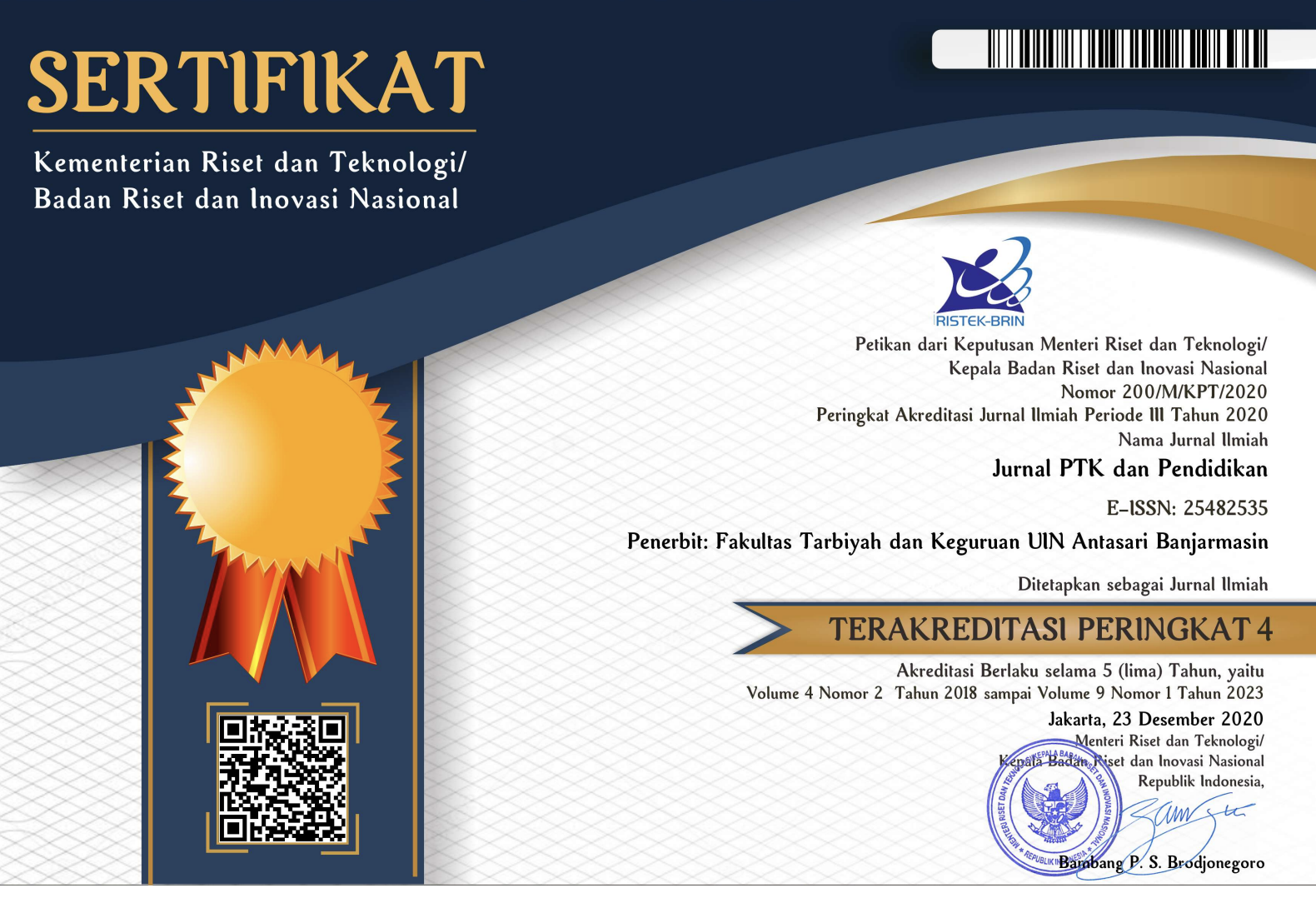THE USE OF THE FLIPPED CLASSROOM METHOD TO IMPROVE STUDENTS' LEARNING OUTCOMES
DOI:
https://doi.org/10.18592/ptk.v10i2.13593Keywords:
flipped classroom, learning independence, improve student learning outcomesAbstract
Learning outcomes are crucial for students, as they reflect their readiness to become lifelong learners and overcome challenges in the modern era. This study aims to improve students' learning outcomes through the flipped classroom method. The research was conducted at SMP Muhammadiyah 1 Gresik with Grade VII B students. It employed a classroom action research design consisting of several stages: pre-cycle, Cycle I, and Cycle II. The process included the following steps: (1) the teacher plans the lesson, (2) the teacher implements the flipped classroom model by reviewing previously delivered material before introducing new content, (3) students are instructed to form groups, (4) the flipped classroom model is used to provide practice questions, and (5) the teacher reflects on the learning process. The results indicate that implementing the flipped classroom method led to an 85% improvement compared to the initial 60%. This demonstrates that the flipped classroom method significantly enhances students' learning outcomes.References
Aswat, H., & Syamsurijal, S. (2019). Penggunaan Model Reciprocal Teaching Untuk Meningkatkan Hasil Belajar Siswa Pada Mata Pelajaran Ipa Kelas V Sd Negeri I Topa Kota Baubau. Sang Pencerah: Jurnal Ilmiah Universitas Muhammadiyah Buton, 4(2), 12–20. https://doi.org/10.35326/pencerah.v4i2.293
Dahniar. (2022). PENERAPAN MODEL INTERAKSI PROMOTIF (FACE TO FACE PROMOTIVE INTERACTION) DALAM PEMBELAJARAN. Azkia : Jurnal Aktualisasi Pendidikan Islam, 19(2), 1–8. http://link.springer.com/10.1007/s00232-014-9701-9%0Ahttp://link.springer.com/10.1007/s00232-014-9700-x%0Ahttp://dx.doi.org/10.1016/j.jmr.2008.11.017%0Ahttp://linkinghub.elsevier.com/retrieve/pii/S1090780708003674%0Ahttp://www.ncbi.nlm.nih.gov/pubmed/1191
Dahry, S. (2020). Peningkatan, Hasil belajar, Mode PENINGKATAN HASIL BELAJAR IPA SISWA KELAS IV MELALUI MODEL PENGAJARAN TERBALIK. Jurnal Tunas Pendidikan, 3(1), 22–32. https://doi.org/10.52060/pgsd.v3i1.368
Damayanti Hutapea, E., & Sitinjak, D. S. (2022). Upaya Pengembangan Koginitif, Afektif Dan Psikomotorik Siswa Dengan Penyelenggaraan Pembelajaran Variatif Efforts To Develop Students’ Coginitive, Affective and Psychomorical By Implementing Variative Learning. Journal of Chemistry and Education Research, 02(01), 1–9.
Darmawati, N. W. S. (2022). Model Pembelajaran Inovatif Bahasa Indonesia Berbasis Flipped Classroom pada Era Digital dengan Pemanfaatan Google Classroom. Jurnal Pendidikan Dan Pembelajaran Bahasa Indonesia, 11(2), 168–177.
Eko Murtiasih. (2022). Implementasi Metode Flipped Classroom Pendidikan Agama Islam Pada Masa Pandemi Covid 19. Risâlah, Jurnal Pendidikan Dan Studi Islam, 8(3), 1018–1032. https://doi.org/10.31943/jurnalrisalah.v8i3.327
Gowder, S. (2016). Pleasant Attitude of a Teacher –A Key Factor in the Success of Education. International Journal of School and Cognitive Psychology, 03(01), 2003. https://doi.org/10.4172/2469-9837.1000e106
Hamdina, W., Idris, A. D., Hendri, J., Susanti, T., & Martha, A. (2024). Peranan Pendidikan Global dalam Meningkatkan Proses Pembelajaran di Sekolah Dasar di Era Globalisasi. Jurnal Pendidikan Tambusai, 8(1), 1205–1210.
Latifah, U., & Rindaningsih, I. (2023). Implementasi Flipped Classroom dalam Mendukung Merdeka Belajar untuk Meningkatkan Kemandirian Belajar. Jurnal Papeda: Jurnal Publikasi Pendidikan Dasar, 5(2), 156–166. https://doi.org/10.36232/jurnalpendidikandasar.v5i2.4447
Mirlanda, E. P., Nindiasari, H., & Syamsuri, S. (2019). Pengaruh Pembelajaran Flipped Classroom Terhadap Kemandirian Belajar Siswa Ditinjau Dari Gaya Kognitif Siswa. Symmetry: Pasundan Journal of Research in Mathematics Learning and Education, 4, 38–49. https://doi.org/10.23969/symmetry.v4i1.1638
Ochoa, J. M. A., & Martinez, A. I. V. (2016). Academic performance in blended-learning and face-to-face university teaching. Asian Social Science, 12(3), 207–221. https://doi.org/10.5539/ass.v12n3p207
Rachma Dianty, S., Wahyu Hidayat Pendidikan Ilmu Pengetahuan Sosial, I., & Ilmu Tarbiyah dan Keguruan, F. (2023). Dinamika Sosial: Jurnal Pendidikan Ilmu Pengetahuan Sosial PENGARUH MODEL PEMBELAJARAN FLIPPED CLASSROOM TERHADAP HASIL BELAJAR IPS SISWA MTs NEGERI 3 MALANG. 2(4), 400–409.
Sahara, R., & Sofya, R. (2020). Pengaruh Penerapan Model Flipped Learning dan Motivasi Belajar Terhadap Hasil Belajar Siswa. Jurnal Ecogen, 3(3), 419. https://doi.org/10.24036/jmpe.v3i3.9918
Savitri, O., & Meilana, S. F. (2022). Pengaruh Model Pembelajaran Flipped Classroom terhadap Pemahaman Konsep IPA Siswa Sekolah Dasar. Jurnal Basicedu, 6(4), 7242–7249. https://doi.org/10.31004/basicedu.v6i4.3457
Situmeang, R., Elindra, R., & Harahap, M. S. (2021). Efektifitas Penggunaan Model Pembelajaran Flipped Clasroom Terhadap Kemampuan Berpikir Kreatif Matematika Siswa Di Kelas Viii Smp Negeri 9 Padangsidimpuan. JURNAL MathEdu (Mathematic Education Journal), 4(2), 278–284. https://doi.org/10.37081/mathedu.v4i2.1793
Sonia, N. R. (2022). Model Flipped Classroom : Alternatif Pembelajaran Di Era New Normal Bagi Siswa Sekolah Dasar. Jurnal IBRIEZ, 7(1), 25–42.
Susanti, L., & Hamama Pitra, D. A. (2019). Flipped Classroom Sebagai Strategi Pembelajaran Pada Era Digital. Health & Medical Journal, 1(2), 54–58. https://doi.org/10.33854/heme.v1i2.242
Downloads
Published
How to Cite
Issue
Section
License
Copyright (c) 2024 Abdul Kholid Achmad, Amilatur Rosidah

This work is licensed under a Creative Commons Attribution 4.0 International License.
- The right to publication of all journal material published on the Jurnal PTK dan Pendidikan website is held by the editorial board with the author's knowledge (moral rights remain the property of the author).
- The formal legal provisions for access to digital articles of this electronic journal are subject to the terms of the Creative Commons CC BY 4.0 DEED Attribution International (CC BY) license. This license enables reusers to distribute, remix, adapt, and build upon the material in any medium or format, so long as attribution is given to the creator. The license allows for commercial use.
- Printed and electronic published manuscripts are open access for educational, research and library purposes. In addition to these objectives, the editorial board shall not be liable for violations of copyright law.






